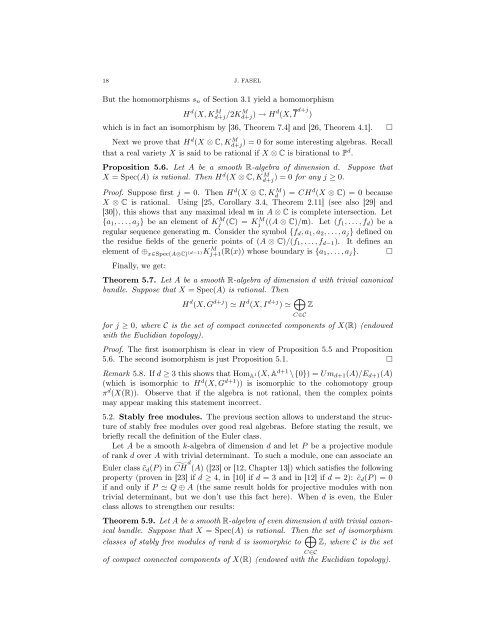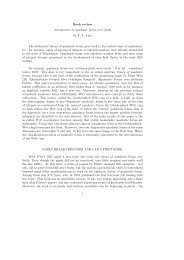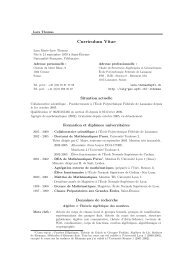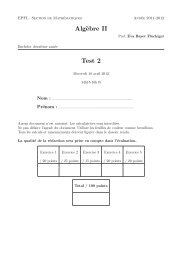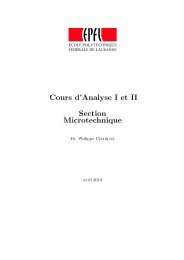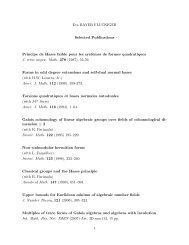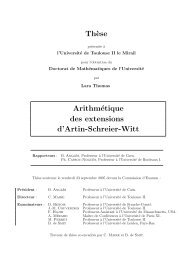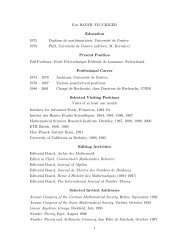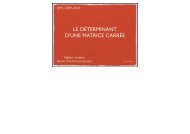Some remarks on orbit sets of unimodular rows - CSAG - EPFL
Some remarks on orbit sets of unimodular rows - CSAG - EPFL
Some remarks on orbit sets of unimodular rows - CSAG - EPFL
You also want an ePaper? Increase the reach of your titles
YUMPU automatically turns print PDFs into web optimized ePapers that Google loves.
18 J. FASEL<br />
But the homomorphisms sn <strong>of</strong> Secti<strong>on</strong> 3.1 yield a homomorphism<br />
H d (X, K M d+j/2K M d+j) → H d (X, I d+j )<br />
which is in fact an isomorphism by [36, Theorem 7.4] and [26, Theorem 4.1]. <br />
Next we prove that Hd (X ⊗ C, KM d+j ) = 0 for some interesting algebras. Recall<br />
that a real variety X is said to be rati<strong>on</strong>al if X ⊗ C is birati<strong>on</strong>al to Pd .<br />
Propositi<strong>on</strong> 5.6. Let A be a smooth R-algebra <strong>of</strong> dimensi<strong>on</strong> d. Suppose that<br />
X = Spec(A) is rati<strong>on</strong>al. Then Hd (X ⊗ C, KM d+j ) = 0 for any j ≥ 0.<br />
Pro<strong>of</strong>. Suppose first j = 0. Then H d (X ⊗ C, K M d ) = CHd (X ⊗ C) = 0 because<br />
X ⊗ C is rati<strong>on</strong>al. Using [25, Corollary 3.4, Theorem 2.11] (see also [29] and<br />
[30]), this shows that any maximal ideal m in A ⊗ C is complete intersecti<strong>on</strong>. Let<br />
{a1, . . . , aj} be an element <strong>of</strong> K M j (C) = KM j ((A ⊗ C)/m). Let (f1, . . . , fd) be a<br />
regular sequence generating m. C<strong>on</strong>sider the symbol {fd, a1, a2, . . . , aj} defined <strong>on</strong><br />
the residue fields <strong>of</strong> the generic points <strong>of</strong> (A ⊗ C)/(f1, . . . , fd−1). It defines an<br />
element <strong>of</strong> ⊕ x∈Spec(A⊗C) (d−1)K M j+1(R(x)) whose boundary is {a1, . . . , aj}. <br />
Finally, we get:<br />
Theorem 5.7. Let A be a smooth R-algebra <strong>of</strong> dimensi<strong>on</strong> d with trivial can<strong>on</strong>ical<br />
bundle. Suppose that X = Spec(A) is rati<strong>on</strong>al. Then<br />
H d (X, G d+j ) H d (X, I d+j ) <br />
Z<br />
for j ≥ 0, where C is the set <strong>of</strong> compact c<strong>on</strong>nected comp<strong>on</strong>ents <strong>of</strong> X(R) (endowed<br />
with the Euclidian topology).<br />
Pro<strong>of</strong>. The first isomorphism is clear in view <strong>of</strong> Propositi<strong>on</strong> 5.5 and Propositi<strong>on</strong><br />
5.6. The sec<strong>on</strong>d isomorphism is just Propositi<strong>on</strong> 5.1. <br />
Remark 5.8. If d ≥ 3 this shows that Hom A 1(X, A d+1 \{0}) = Umd+1(A)/Ed+1(A)<br />
(which is isomorphic to H d (X, G d+1 )) is isomorphic to the cohomotopy group<br />
π d (X(R)). Observe that if the algebra is not rati<strong>on</strong>al, then the complex points<br />
may appear making this statement incorrect.<br />
5.2. Stably free modules. The previous secti<strong>on</strong> allows to understand the structure<br />
<strong>of</strong> stably free modules over good real algebras. Before stating the result, we<br />
briefly recall the definiti<strong>on</strong> <strong>of</strong> the Euler class.<br />
Let A be a smooth k-algebra <strong>of</strong> dimensi<strong>on</strong> d and let P be a projective module<br />
<strong>of</strong> rank d over A with trivial determinant. To such a module, <strong>on</strong>e can associate an<br />
Euler class ˜cd(P ) in CH d<br />
(A) ([23] or [12, Chapter 13]) which satisfies the following<br />
property (proven in [23] if d ≥ 4, in [10] if d = 3 and in [12] if d = 2): ˜cd(P ) = 0<br />
if and <strong>on</strong>ly if P Q ⊕ A (the same result holds for projective modules with n<strong>on</strong><br />
trivial determinant, but we d<strong>on</strong>’t use this fact here). When d is even, the Euler<br />
class allows to strengthen our results:<br />
Theorem 5.9. Let A be a smooth R-algebra <strong>of</strong> even dimensi<strong>on</strong> d with trivial can<strong>on</strong>ical<br />
bundle. Suppose that X = Spec(A) is rati<strong>on</strong>al. Then the set <strong>of</strong> isomorphism<br />
classes <strong>of</strong> stably free modules <strong>of</strong> rank d is isomorphic to <br />
Z, where C is the set<br />
<strong>of</strong> compact c<strong>on</strong>nected comp<strong>on</strong>ents <strong>of</strong> X(R) (endowed with the Euclidian topology).<br />
C∈C<br />
C∈C


